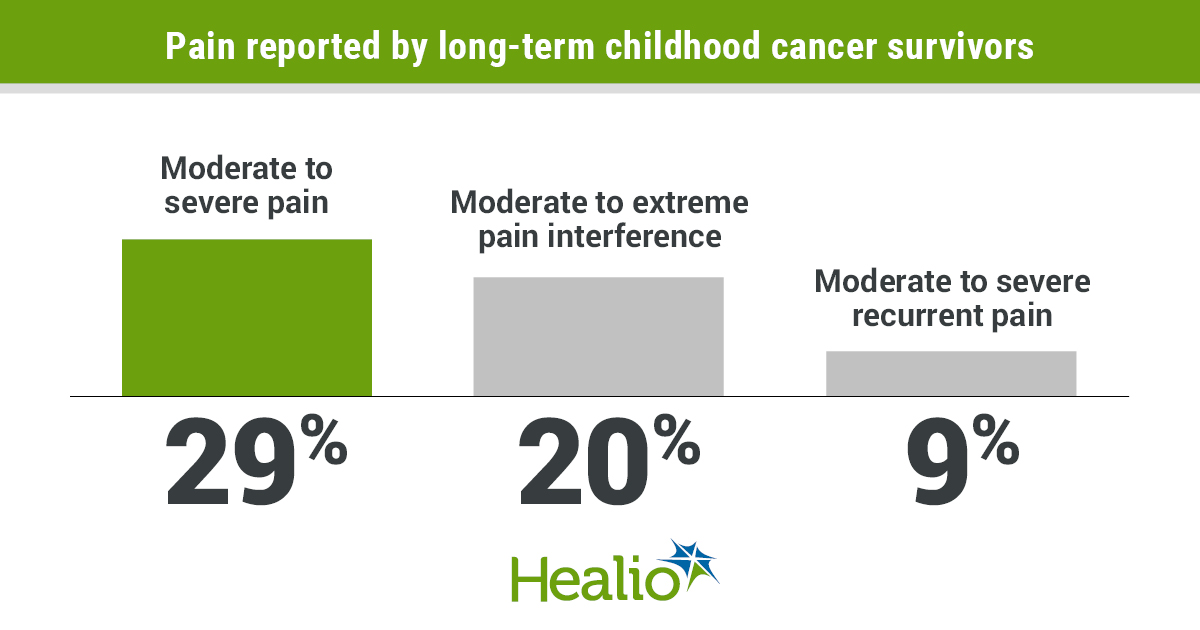Some childhood cancer survivors at higher risk for pain as adults

Certain long-term childhood cancer survivors appeared more likely than their siblings who never had cancer to experience pain as adults, according to a report of the Childhood Cancer Survivor Study published in Cancer.
“Pain is a debilitating medical condition that interferes with every aspect of an individual's life. Increasing our understanding of pain in childhood cancer survivors and identifying risk factors for pain is important for maximizing quality of life in survivors,” Cindy W. Karlson, PhD, associate professor and director of inpatient pediatric psychology services at The University of Mississippi Medical Center, told Healio. “The Childhood Cancer Survivor Study provides a unique opportunity to examine pain in survivors over time.”
Karlson and colleagues sought to characterize the prevalence of and risk for pain, pain that causes clinically significant interference in daily activities (pain interference) and recurrent pain among 10,012 adult survivors of childhood cancer (median age, 31 years; 48.7% women; median time since diagnosis, 23 years). Common cancer types among participants included leukemia (34%), Hodgkin lymphoma (12.7%) and central nervous system malignancy (12.5%).
The researchers also evaluated a comparison group of 3,173 siblings of a similar age who never had cancer.

The Bodily Pain scale of the 36-item Short Form Health Survey was used to derive three primary pain outcomes — pain, pain interference and recurrent pain. Study participants completed questionnaires at follow-up two (beginning in 2002) and/or follow-up four (beginning in 2007).
Researchers used multinomial logistic regression to assess associations between risk factors — such as demographics, cancer-related factors and psychological symptoms — and pain, pain interference and recurrent pain. They examined cross-sectional associations between risk factors and pain outcomes through path analyses.
Compared with siblings, childhood cancer survivors had higher incidence of severe/very severe pain (RR = 1.28; 95% CI, 1.07-1.54), quite a bit/extreme pain interference (RR = 1.26; 95% CI, 1.06-1.51), and moderate to severe recurrent pain (RR = 1.23; 95% CI, 1.02-1.49). Overall, 29% of survivors reported moderate to severe pain, 20% reported moderate to extreme pain interference, and 9% reported moderate to severe recurrent pain.
Between follow-up two and follow-up four, trajectories of pain (RR = 1.21; 95% CI, 1.01-1.45) and pain interference (RR = 1.33; 95% CI, 1.09-1.62) appeared to worsen among survivors.
At follow-up two, survivors reported more symptoms of depression (mean, 49.2 vs. 47; P < .001) and anxiety (mean, 47.8 vs. 46.8; P < .001) compared with siblings, and were more likely to have grade 3 to grade 4 chronic medical conditions (27.1% vs. 6.6%; P < .001).
Demographic, disease factors
Researchers found that female cancer survivors consistently had higher risk for severe/very severe late-occurrence pain (RR = 1.5; 95% CI 1.49-1.51), quite a bit/extreme pain interference (RR = 1.51; 95% CI, 1.49-1.53) and moderate to severe recurrent pain (RR = 1.33; 95% CI, 1.32-1.34), as well as a 19% to 29% increased risk for worse pain and pain interference trajectories.
Minority survivors also had higher risk for moderate to severe recurrent pain (RR = 0.89; 95% CI, 0.88-0.9), worsened pain interference (RR = 1.11; 95% CI, 1.11-1.12) and persistent pain interference (RR = 0.78; 95% CI, 0.77-0.78).
Moreover, each year older at cancer diagnosis appeared associated with a 1% to 3% increased risk for late-occurrence pain, pain interference and moderate to severe recurrent pain.
Survivors of sarcomas/bone tumors demonstrated higher risk for severe late-occurrence pain (RR = 1.47; 95% CI, 1.45-1.49), quite a bit/extreme pain interference (RR = 1.38; 95% CI, 1.35-1.41) and moderate to severe recurrent pain (RR = 1.33; 95% CI, 1.32-1.34) than leukemia survivors.
For every 10 Gy increase in chemoradiation dose, researchers observed an increase in risk for moderate late-occurrence pain and pain interference (RRs = 1.02).
Further, the use of platinum-based chemotherapy appeared associated with an increased risk for moderate and severe late-occurrence pain and pain interference (RRs = 1.02-1.17).
Survivors with grade 3 to grade 4 chronic medical conditions experienced worse late-occurrence pain and pain interference outcomes (RRs = 1.33-2.06), as well as moderate to severe recurrent pain, worsened pain trajectory and worsened/persistent pain interference trajectory (RRs = 1.25-1.53).
Depression and anxiety
Other factors associated with increased risk for all pain outcomes among survivors included depression and anxiety. For every half standard deviation increase in depression from follow-up two to follow-up four, researchers observed a 12% higher risk for worsened pain trajectory and a 16% higher risk for worsened pain interference trajectory.
Anxiety was associated with higher risk for moderate to severe recurrent pain (RR = 1.27; 95% CI, 1.26-1.28), worsened pain trajectory (RR = 1.27; 95% CI, 1.24-1.3), worsened pain interference (RR = 1.11; 95% CI, 1.08-1.13) and persistent pain interference (RR = 1.15; 95% CI, 1.12-1.18).
Researchers also observed associations between antidepressant use and worse pain outcomes (RRs = 1.22-2.44). Of note, use of analgesics appeared associated with the greatest risk for worse pain outcomes among survivors, with risk increases of 126% to 700%, researchers noted.
“Medical teams are encouraged to discuss future risks with active patients nearing completion of therapy, and to screen for these risk factors in relation to pain during long-term follow-up clinic visits and intervene early,” Karlson told Healio. “I am grateful to the Childhood Cancer Survivor Study team for our collaboration on this project. Several collaborators from this project are currently working on additional research to better understand the rates of pain and current methods of measuring pain in childhood cancer survivors. There are also interventions being developed and pilots in the Childhood Cancer Survivor Study to help reduce pain and pain interference.” – by Jennifer Southall
For more information:
Cindy W. Karlson, PhD, can be reached at The University of Mississippi Medical Center, 2500 N. State St., Jackson, MS 39216; email: ckarlson@umc.edu.
Disclosures: The study was supported by NCI, Cancer Center Support and American Lebanese Syrian Associated Charities. The authors report no relevant financial disclosures.

